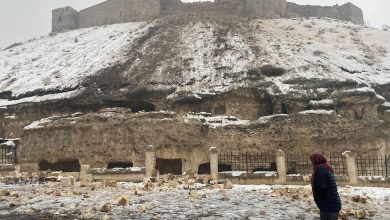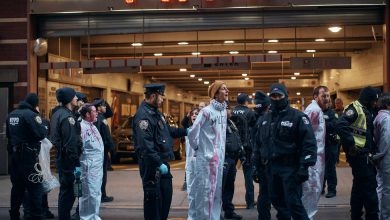Judge Keeps New York’s New Electoral Map Intact for Now

A New York appellate judge on Monday hit the brakes on a sweeping lower-court decision that invalidated newly drawn legislative districts favorable to Democrats and threatened to throw the state’s election season into turmoil.
Justice Stephen K. Lindley of New York’s Fourth Appellate Department in Rochester issued the temporary stay after state Democratic leaders formally contested the lower court’s opinion last week that the maps were unconstitutional and, in some cases, gerrymandered for partisan gain.
He did not address the merits of the case but indicated that he hoped to expedite his own ruling on whether the lines were constitutional.
“The appeal will be greatly accelerated for obvious reasons, and I anticipate that a decision could be rendered within the next three weeks, if not sooner,” Justice Lindley wrote in a note instructing both Democrats and the Republicans challenging the maps to attend a Thursday hearing.
In the short term, the stay means that the maps approved by the Democrat-led Legislature in February, as well as the state’s June primary calendar, will remain in effect. But it remains to be seen whether the maps will survive the appeals process.
What to Know About Redistricting
- Redistricting, Explained: Here are some answers to your most pressing questions about the process that is reshaping American politics.
- Understand Gerrymandering: Can you gerrymander your party to power? Try to draw your own districts in this imaginary state.
- Analysis: For years, the congressional map favored Republicans over Democrats. But in 2022, the map is poised to be surprisingly fair.
- Killing Competition: The number of competitive districts is dropping, as both parties use redistricting to draw themselves into safe seats.
Analysts generally believe the Appellate Division is more likely to defer to the Legislature’s prerogative to draw the maps and less likely to intercede in a way that would blow up this year’s elections calendar than was the lower court judge, Patrick F. McAllister, a State Supreme Court justice in rural Steuben County and a Republican.
The outcome in New York has attracted intense national interest, with partisan control of three to four seats in the House of Representatives hanging in the balance at a time when the two parties are vying for the majority from coast to coast. The New York lines as currently construed promise to boost House Democrats while also safeguarding the party’s State Senate majority, prompting national Republicans to spend richly on the legal challenge.
Inside New York, the tangled legal machinations have had a more immediate effect on candidates for office from both parties, who are watching the proceedings carefully.
Before it was stayed, Justice McAllister’s decision had set campaigns racing to determine what districts — if any — they were actually running in. Candidates who had already spent a month gathering petitions to run in the newly drawn congressional, State Senate and Assembly districts faced the prospect that the lines would be erased, their costly work temporarily nullified and June’s primary elections postponed just days before the petitioning process was scheduled to end.
“On the eve of the petitioning deadline, candidates, incumbents and insurgents alike were thrown for a loop,” said Jerry H. Goldfeder, an elections lawyer at Stroock & Stroock & Lavan who advises Democratic candidates.
He called it “a perfect example of why courts shouldn’t interfere with election procedures at the 11th hour.”
Though Justice McAllister did not explicitly delay the primary, his order for lawmakers to redraw new district lines that could win bipartisan support almost certainly would have required the primary to be rescheduled.
The ruling prompted the State Board of Elections to issue guidance late last week that prematurely said the decision had been stayed and advised candidates that “all other deadlines provided for by law are still in effect pending further court determinations and the petitions would still be due this week.”
How U.S. Redistricting Works
What is redistricting? It’s the redrawing of the boundaries of congressional and state legislative districts. It happens every 10 years, after the census, to reflect changes in population.
Why is it important this year? With an extremely slim Democratic margin in the House of Representatives, simply redrawing maps in a few key states could determine control of Congress in 2022.
How does it work? The census dictates how many seats in Congress each state will get. Mapmakers then work to ensure that a state’s districts all have roughly the same number of residents, to ensure equal representation in the House.
Who draws the new maps? Each state has its own process. Eleven states leave the mapmaking to an outside panel. But most — 39 states — have state lawmakers draw the new maps for Congress.
If state legislators can draw their own districts, won’t they be biased? Yes. Partisan mapmakers often move district lines — subtly or egregiously — to cluster voters in a way that advances a political goal. This is called gerrymandering.
What is gerrymandering? It refers to the intentional distortion of district maps to give one party an advantage. While all districts must have roughly the same population, mapmakers can make subjective decisions to create a partisan tilt.
Is gerrymandering legal? Yes and no. In 2019, the Supreme Court ruled that the federal courts have no role to play in blocking partisan gerrymanders. However, the court left intact parts of the Voting Rights Act that prohibit racial or ethnic gerrymandering.
Want to know more about redistricting and gerrymandering? Times reporters answer your most pressing questions here.
But after the board posted that guidance on Twitter, lawyers for the Republican plaintiffs said the messages were spreading misinformation. On Friday, they sent a cease-and-desist letter demanding that the state remove the Twitter post unless and until there was an actual stay from a judge, which did not come until Monday.
John J. Faso, a former Republican congressman aiding the Republican lawsuit, conceded that Justice Lindley’s stay had now clarified the situation, but he predicted that his side would still prevail in the appeals process.
“While Democrats want to delay the judicial process so that they can run one election on these unconstitutional maps, we are confident the courts will see through that gambit and will order constitutional maps for the 2022 elections,” Mr. Faso said on Monday.
The higher courts could uphold or overturn Justice McAllister’s decision, or they could choose another option: order the maps to be redrawn, but not until after this year’s election. Such a scenario would be likely to mean that New York would hold legislative elections in 2022 and again in 2023.
With that in mind, Christine C. Quinn, a top Democratic Party official, said her advice to those seeking office was simple and consistent: “People should keep running, keep running hard, stick with the campaign plan that they had from Day 1.”
She added, “This is not unusual.”





